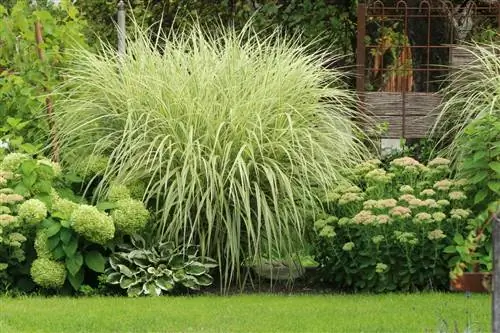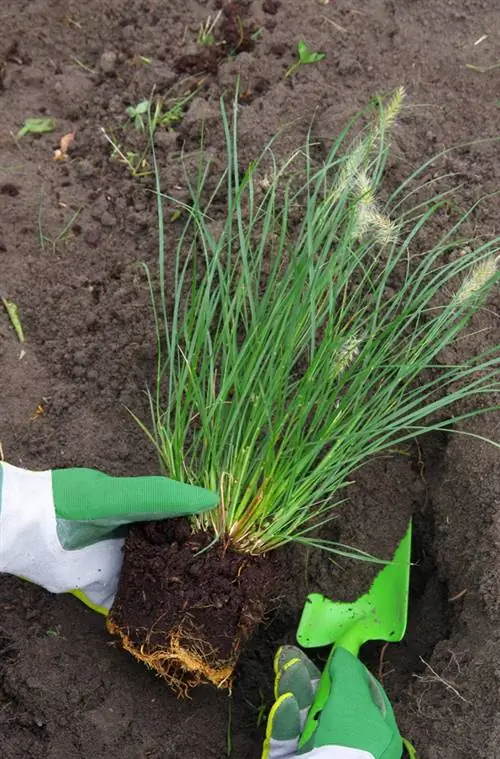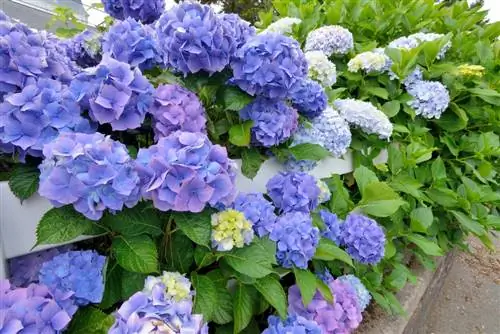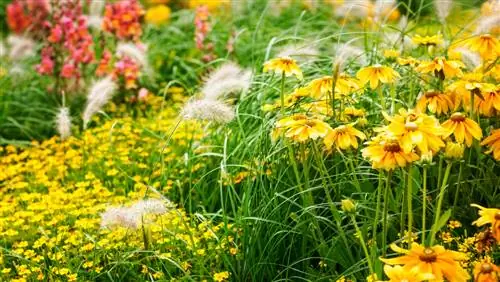- Author admin [email protected].
- Public 2024-01-31 08:49.
- Last modified 2025-01-23 11:19.
Hortensas thrive in both sunny and shady locations, depending on the variety. This makes them ideal for combining with grasses in beds at any location. The grasses should frame the hydrangea and not become the sole eye-catcher. To create a harmonious atmosphere, do not mix too many types and colors of hydrangeas.
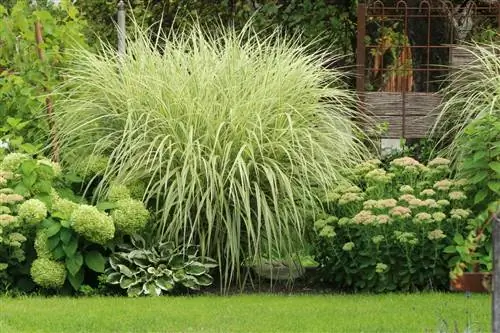
Which grasses can hydrangeas be combined with?
Hydrangeas can be combined with grasses in any location. Dewdrop grass, diamond grass and miscanthus are suitable for sunny locations. Combinations in partial shade include mushroom sedge, woodland sedge and pipe grass. Forest marbel, Japanese rainbow fern and giant sedge prefer shady locations.
Selection of location and substrate
In their natural environment, hydrangeas often thrive inshady locationsHowever, a few species also prefer full sun locations. In any case, the chosen location should be wellprotected from wind. Many hydrangeas suffer from icy gusts, especially in the winter months. In addition to the cold itself, the drying out of the soil is particularly dangerous for the hydrangea to overwinter.
Hydrangeas forsunny Locations:
- Oak-leaved hydrangea (single genera)
- panicle hydrangea
- Snowball hydrangea
Hydrangeas forpartial shade Locations:
- Modern Farm Hydrangea
- Rough leaf hydrangea
- Giant leaf hydrangea
- Velvet Leaf Hydrangea
Hydrangeas forshady Locations:
- Ball hydrangea
- Farmer Hydrangea
- Oak-leaved hydrangea (single genera)
- Climbing hydrangea
- Plate hydrangea
- Forest hydrangea
The ideal soil should behumousandloose. Hydrangeas also neednutrient-rich soil. By regularly adding fertilizer, missing nutrients can be added to the substrate in the required quantities. You can find helpful tips on the correct use of fertilizers here.
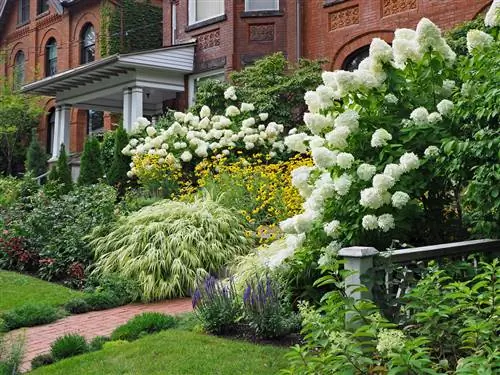
For long-lasting and intense blooms, the hydrangea needs a species-appropriate location. Also pay attention to the pH value of the soil with colored flowers.
Special attention should be paid to thepH value. Whether the plant species prefers acidic or alkaline soil can be seen by the flower color. While pink and red flowering varieties prefer a basic pH value (>8), all other color variants require an acidic pH value (<5-6). To lower the pH value, aluminum sulfates and potassium are recommended, which are contained in special fertilizers (€8.00 on Amazon). Additives containing lime and iron are suitable for increasing the pH value. You can change the pH value by using the right fertilizer. However, always pay attention to the requirements and compatibility of the other bedding plants.
Combine hydrangeas in the sun
For a sunny grass bed we recommendOak-leaved hydrangeas,Pranicle hydrangeasandSnowball hydrangeas These are often kept in muted colors, so that both flowers of the same color and different colors can be combined well. You can combine these types of hydrangeas with the following listed grasses.
Small grasses for sunny locations:
- Gold-edged sedge
- Mariengrass
- Dewdrop Grass
Medium-tall grasses for sunny locations:
- Pheasant Tail Grass
- Flatgrass
- Diamondgrass
Tall grasses for sunny locations:
- Pampas grass
- Switchgrass
- miscanthus
Example planting for the sun
The combination of panicle hydrangea, magnificent candle, feather grass and verbena is ideal for sunny locations in the garden. Panicle hydrangea is an attractive perennial with large flower spikes that bloom from July to September and attract a variety of insects. The magnificent candle blooms from June to August and produces long, slender inflorescences that bring a beautiful vertical structure to the bed. Feather grass is a type of grass that has a textural effect with its soft, feathery inflorescences. Verbena attracts bees and butterflies. The combination of these four plants offers a beautiful color palette, different heights and textures, and thus creates a harmonious and varied bed design.

Combine hydrangeas in partial shade
Hydrangeas of the generaModern farmer's hydrangea,Rough leaf hydrangea,Giant leaf hydrangeaandVelvet leaf hydrangea These perennials generally thrive particularly well in this location. The reason for this is that they are based on the natural occurrence of the hydrangea. Partially shaded locations are characterized by four hours of sun per day. The bed is in the shade for the rest of the day. The grasses listed in the following list are also suitable for partially shaded locations.
Small grasses for partially shaded locations:
- Mushroomhead sedge
- Single-flowered pearl grass
- Japan gold ribbon grass
Medium-tall grasses for partially shaded locations:
- Forest-Schmiele
- Japanese mountain grass
- Palm frond sedge
Tall grasses for partially shaded locations:
- Pipegrass
- Moor Pipe Grass
- Mountain Riding Grass
Example planting for partial shade
The combination of modern farmer's hydrangea, pampas grass, quaking grass and cushion-like garden sedge is ideal for semi-shady locations in the garden. These plants thrive in moderate sunlight and require well-drained soil. The modern farmer's hydrangea is a beautiful perennial with large, impressive flowers and a long flowering period from July to October. Pampas grass is a large, graceful type of grass that brings an impressive vertical dimension to the bed with its large, fluffy inflorescences. The quaking grass has a fine texture and moves gently in the wind, giving the bed a relaxed atmosphere. The cushion-like garden sedge fills the space between the other plants and offers a beautiful ground cover with its dense, green leaves. Together, these four plants form a harmonious group with varied height, texture and color.

Combine hydrangeas in the shade
A variety of different species are also suitable for a shady location. For a bed in the shade are theBall Hydrangea, theFarmer Hydrangea, theOak-leaved Hydrangea(individual genera), theclimbing hydrangea, theplate hydrangeaand theforest hydrangea can be used. A shade bed is characterized by little to no direct sun and less than four hours of sunshine per day. The following grasses are also suitable for shady locations.
Small grasses for shady locations:
- worm fern
- Forest Marbel
- Broadleaf sedge
Medium-tall grasses for shady locations:
- Japanese sedge
- Japanese Rainbow Fern
- Downy Feather Filigree Fern
Tall grasses for shady locations:
- Giant sedge
- Bamboo (root barrier required)
- Forest Lady Fern
Example planting for shade
Hydrangeas, hostas and worm ferns are perfect shade plants and can be combined well with each other. Hydrangeas and hostas prefer moist soil and moderate sunlight, while worm ferns also thrive in drier, shady areas. Worm fern is an alternative to grasses because it has a delicate texture, grows well in the shade and does not form annoying flower or seed heads. Together they form a harmonious backdrop and offer an attractive and low-maintenance way to create shady areas in gardens and landscapes.
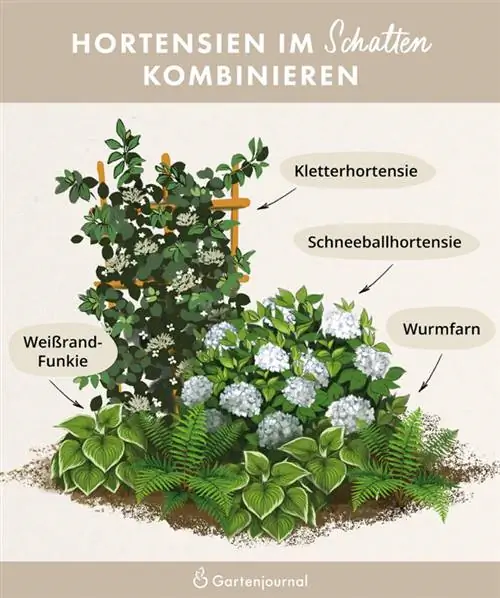
Grasses as ground cover for hydrangeas
Due to their pronounced height and width growth, a variety of ground cover plants are also suitable in addition to the previously mentioned plant neighbors. In addition to foliage perennials such as hostas and purple bells, low ornamental grasses such as sedges and shrubs such as fine-leaved evergreens can also be planted under hydrangea. The rapid and dense growth counteracts the drying out of the upper layers of the earth caused by wind and sun.

Hydrangeas in particular are suitable for underplanting with ground cover (here Gold Japan Mountain Grass “Aureola”).
Alternatively, a number of perennials can also be used for underplanting. Compatible partners for the hydrangea are:
- Barberry
- Elf Flower
- Rock Cranesbill
- Autumn Anemone
- Japanese Ysander
- ragwort
- Spanish lungwort
FAQ
Which grasses can hydrangeas be combined with?
Possible planting partners are sedges, feather bristle grass, feather grass, pennisetum grass, pampas grass and miscanthus.
Which grasses and hydrangeas prefer a shady location?
When it comes to grasses, different types of sedge can be used, for example the broadleaf sedge, palm frond sedge and the giant sedge. Snow marbel and forest marbel can also be planted in places with little light. These are supplemented by the ball hydrangea, the farmer's hydrangea, the oak-leaved hydrangea (individual genera), the climbing hydrangea, the plate hydrangea or the forest hydrangea.
Which location is suitable for hydrangeas?
Based on their natural occurrence, most types of hydrangea prefer a shady to semi-shady location. However, a few varieties are also suitable for full sun locations, although the care required for these is significantly higher.
How much water do hydrangeas need?
The plants need more moisture in sunny places than in shadier ones. High temperatures and a lot of wind movement cause the soil to dry out more quickly. Therefore, check the moisture content of the substrate regularly using a finger test. In any case, avoid waterlogging as this can lead to rot at the roots.
Which soil is suitable for hydrangeas?
Hydrangea prefers a humus-rich, nutrient-rich and loose soil. The commercially available substrate mixtures for hydrangeas and rhododendrons already have the optimal consistency and nutrient density. Alternatively, you can also make your own mixture of expanded clay, garden soil, chopped wood, compost, sand and rotted leaves.

